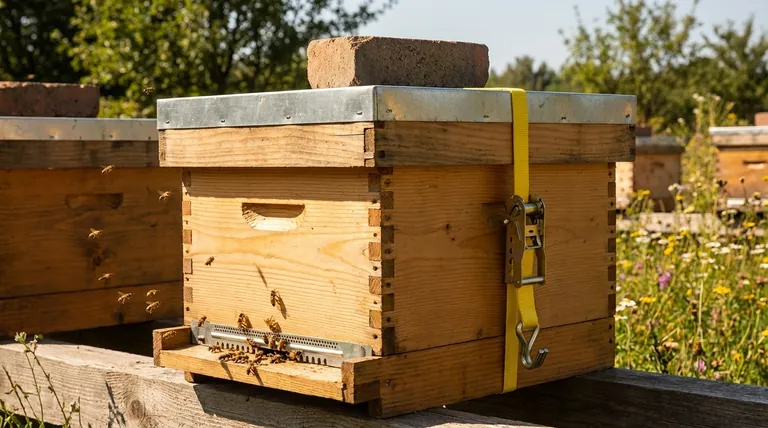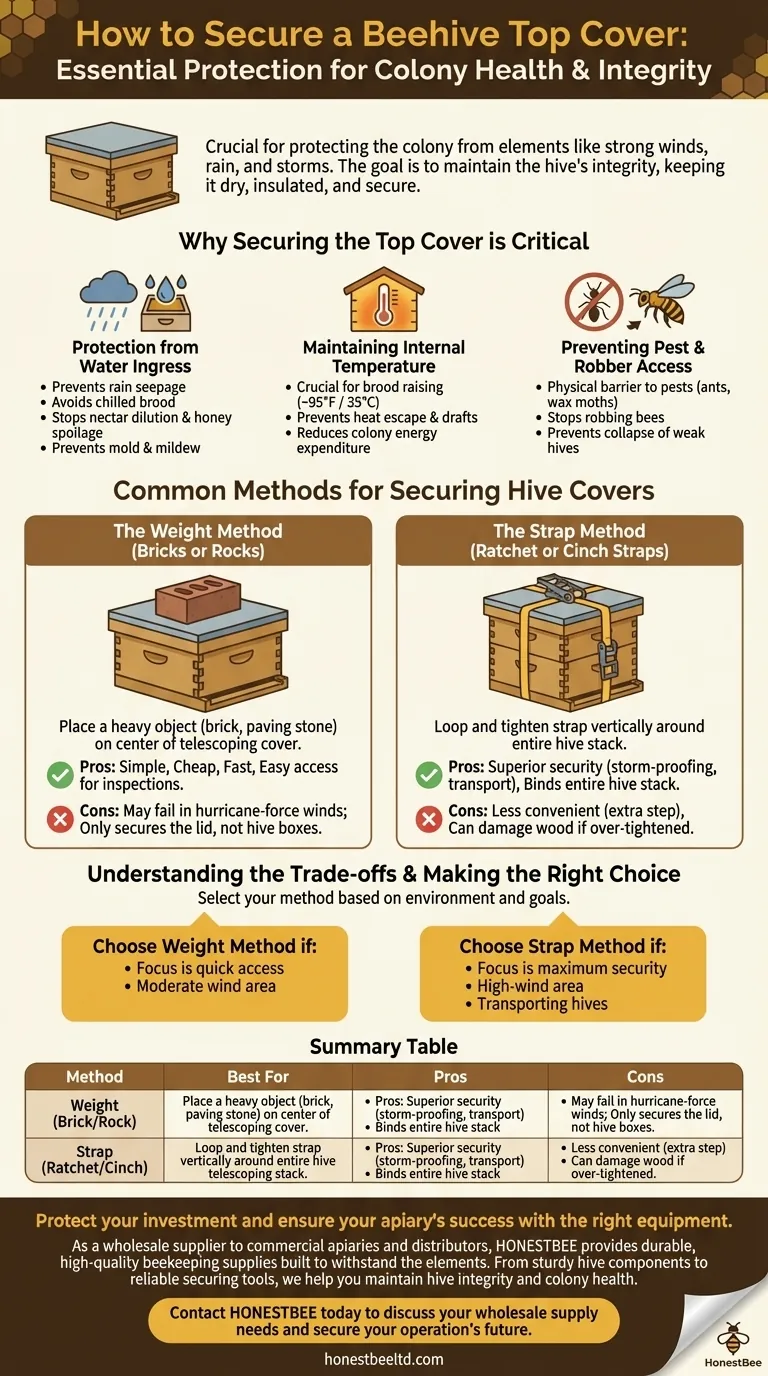To secure the top cover of a beehive, beekeepers typically use either added weight, such as a brick or heavy rock, or adjustable straps that wrap around the hive body. This simple step is crucial for protecting the colony from the elements, especially in areas prone to strong winds or storms.
While a simple weight or strap solves the immediate problem of a loose cover, the real goal is to maintain the hive's integrity against weather, ensuring the colony remains dry, insulated, and secure from external threats.

Why Securing the Top Cover is Critical
A stable top cover is the hive's first line of defense. A cover that is displaced, even slightly, can lead to serious problems for the colony.
Protection from Water Ingress
A dislodged cover allows rain to seep into the hive. This moisture can chill the brood, dilute nectar, spoil stored honey, and promote the growth of mold and mildew, creating an unhealthy environment for the bees.
Maintaining Internal Temperature
Bees work constantly to regulate the hive's internal temperature, which is vital for raising brood (around 95°F or 35°C). A loose-fitting cover creates drafts and allows precious heat to escape, forcing the colony to expend more energy and resources just to stay warm.
Preventing Pest and Robber Access
A secure lid is a physical barrier. A gap created by a shifted cover is an open invitation for pests like ants and wax moths, or for robbing bees from other colonies to steal honey, which can lead to the collapse of a weak hive.
Common Methods for Securing Hive Covers
Beekeepers have two primary, time-tested methods for keeping lids in place. The choice often depends on local weather conditions and personal preference.
The Weight Method (Bricks or Rocks)
This is the most common and straightforward approach. Simply placing a heavy, flat object like a brick, paving stone, or large rock on the center of the telescoping outer cover is often enough.
The weight provides sufficient force to hold the lid down during normal winds and storms. It's fast, cheap, and makes accessing the hive for inspections quick and easy.
The Strap Method (Ratchet or Cinch Straps)
For superior security, especially in hurricane-prone regions or when transporting hives, beekeepers use ratchet straps.
A strap is looped vertically around the entire hive, from the bottom board to the top cover, and tightened. This not only secures the lid but also binds all the hive boxes (supers) together into a single, stable unit.
Understanding the Trade-offs
Neither method is perfect for every situation. Understanding their pros and cons is key to making an informed decision.
Weight: Simplicity vs. Security
The primary advantage of using a brick is its simplicity. It costs nothing and requires no effort to remove or replace during an inspection.
However, a heavy weight may not be enough to withstand hurricane-force winds. It also only secures the lid itself, not the underlying boxes, which could still shift relative to one another in extreme conditions.
Straps: Security vs. Convenience
Straps offer unmatched security, holding the entire hive stack firmly together. This is the gold standard for storm-proofing or moving bees.
The main drawback is convenience. Undoing and re-tightening a ratchet strap adds an extra step to every hive inspection, which can become tedious. If over-tightened, straps can also dig into and damage the wooden components over time.
Making the Right Choice for Your Apiary
Select your method based on your specific environment and beekeeping goals.
- If your primary focus is quick access and you live in an area with moderate wind: A heavy brick or flat rock placed on the cover is a reliable and efficient solution.
- If your primary focus is maximum security in a high-wind area or you plan to transport hives: A ratchet strap that encircles the entire hive is the most robust and dependable choice.
Securing your hive cover is a simple action that provides fundamental protection for your colony's long-term health and productivity.
Summary Table:
| Method | Best For | Pros | Cons |
|---|---|---|---|
| Weight (Brick/Rock) | Moderate wind areas; quick access | Simple, cheap, fast for inspections | May not hold in extreme winds; doesn't secure hive boxes |
| Strap (Ratchet/Cinch) | High-wind/storm areas; hive transport | Maximum security; holds entire hive together | Less convenient for frequent inspections; can damage wood if over-tightened |
Protect your investment and ensure your apiary's success with the right equipment.
As a wholesale supplier to commercial apiaries and distributors, HONESTBEE provides durable, high-quality beekeeping supplies built to withstand the elements. From sturdy hive components to reliable securing tools, we help you maintain hive integrity and colony health.
Contact HONESTBEE today to discuss your wholesale supply needs and secure your operation's future.
Visual Guide

Related Products
- Professional Galvanized Hive Strap with Secure Locking Buckle for Beekeeping
- Endless Loop Ratchet Hive Strap
- Professional Insulated Winter Hive Wrap for Beekeeping
- HONESTBEE Advanced Ergonomic Stainless Steel Hive Tool for Beekeeping
- Professional Dual-End Stainless Steel Hive Tool for Beekeeping
People Also Ask
- Why are hive straps important for beekeepers? Secure Your Hives Against Wind, Predators & Transport
- What are the two styles of hive straps? Choose the Right Strap for Your Hive Security
- What maintenance is required for hive straps? A Guide to Cam Buckle vs. Ratchet Strap Care
- How should a cam buckle strap be installed for optimal performance? Master the Leverage for Maximum Tension
- What is the advantage of using cam buckle straps? Secure Your Load Fast with Simple, Safe Tensioning



















